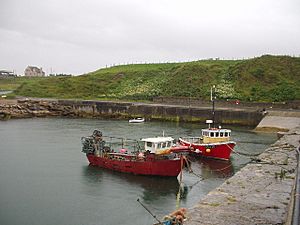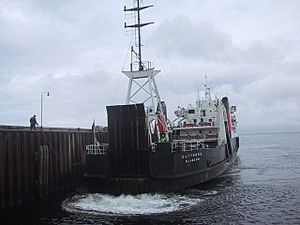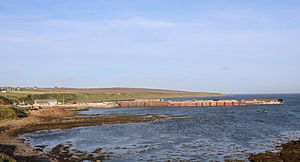Gills Bay facts for kids
Gills Bay is a beautiful bay located about 3 kilometres (2 miles) west of John o' Groats in Caithness, Scotland. The small community of Gills is also nearby. This area has one of the longest stretches of flat, rocky coastline on the northern shores of Caithness.
The main parts of Gills Bay are a small harbour and a pier. This pier is used as the main terminal on the mainland for Pentland Ferries. The harbour provides shelter for small local boats. It also helps boats used to work with the sheep on the nearby island of Stroma. When the sea conditions are right, Gills Bay is sometimes a good spot for surfing.
The Short Sea Crossing
The ferry route from Scrabster to Stromness has been used for a long time, starting in 1856. However, Gills Bay has historically been the main starting point from the mainland to the islands of Stroma, Swona, and even Orkney itself.
This route is known as "The Short Sea Crossing." Many people believe it is the quickest and safest way to cross the waters of the Pentland Firth. Today, Pentland Ferries runs a service all year round on this route. Their ferries travel to St Margaret's Hope on South Ronaldsay in Orkney.
History of the Bay
The first pier at Gills Bay was built in 1905. The harbour was added some time after that.
In the 1980s, the Orkney Island Council decided to bring back the short sea crossing. This new service would go from Gills Bay to Burwick on South Ronaldsay. A lot of money was spent on a new ferry and building a terminal at Gills Bay. Similar facilities were also built at Burwick.
The service began on August 15, 1989. However, it sailed to Houton instead of Burwick at first, because dredging work was still needed at Burwick. The service ended quickly on September 16, 1989. This happened because the linkspan (a ramp connecting the ferry to the land) at Gills Bay was damaged by bad weather.
It became clear that running a regular service would be very difficult due to the strong weather. So, the operation was stopped. The ferry was later used by Orkney Ferries for travel between the islands. More recently, Burwick has been used by a passenger-only ferry that runs from John o' Groats during the summer months.
In the late 1990s, an entrepreneur from Orkney named Andrew Banks saw the potential of the short sea crossing. He was the founder of Pentland Ferries. He tried to get permission to use the old terminal. The council only agreed after he threatened to build his own terminal nearby. He then got a 99-year lease for the site.
Andrew Banks worked for two years, living in a caravan on site. He had help from a few local workers and some used construction machines. He worked hard to make the terminal stronger against the rough waves and weather. This involved building a new pier. He also used the "dolphins" (strong structures that a ship rests against) that the previous operators had built. Some dredging work was also done to make the water deeper.
By the summer of 2001, Pentland Ferries was ready to start regular trips. Their vessel, the MV Pentalina-B, began sailing to St Margaret's Hope. Soon, they realized that even with these improvements, there would still be problems. A much longer pier was needed.
Luckily, an old floating dock was available in Lerwick. This dock was bought and towed to St Margaret's Hope. There, it was cleaned of any harmful materials. Then, it was towed to Gills Bay and sunk. This created a longer pier, making it much easier for the ferry. Old oil transfer hoses from the Scapa Flow oil terminal were used as fenders. These protect the ferry when it docks. Large rocks were also placed on the sea side to protect against waves. The tanks of the old dock have been filled with concrete. The dock itself has been filled with material from dredging. This creates more space for the ferry to move around. Eventually, this old dock will become a full part of the pier.
Currently, this part of the pier is officially called a "wreck." It shows two green lights at its end, instead of the two red lights a normal pier would show. All this work is paid for by the ferry company, so it continues slowly as money allows. There are plans to continue dredging to make enough room for a ferry to turn around if needed. They also hope to extend the pier again at an angle. This would help stop the strong waves that sometimes make it hard to use the linkspan. This work is planned for after the summer of 2008.
Amazing Wildlife
You can see seals in Gills Bay all year round. They are often on the rocks or swimming in the water. They usually rest on the rocks when the tide is going out (ebb tide). This way, they don't have to move as the water rises. You can often spot some seals close to the far (west) side of the pier. A larger group is usually found on rocks a few hundred yards away, on the harbour side.
The grey seal is the most common type of seal here. This area has one of the largest populations of grey seals in Britain. However, the common seal is also present.
Porpoises can be seen all year round in the Pentland Firth and at Gills Bay. They tend to like shallower water. You usually see them alone or in small groups. But in the autumn, many large groups gather in Gills Bay.
Basking sharks are rare visitors, but they are being seen more often. They usually appear between May and August. You might see them feeding close to the shore at high tide around the Gills Bay / Stroma area. They can also be seen in deeper water.




